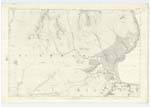OS1/6/3/101
| List of names as written | Various modes of spelling | Authorities for spelling | Situation | Description remarks |
|---|---|---|---|---|
| GOAT FELL | Goat Fell Goatfell Goat Fell Goat Fell Gaotshven (from sound) Gaotshven (from sound) Gaotshven (from sound) |
Estate Plan Map in Bryce's Geology Philip's County Atlas Rev. [Reverend] Mr Blackloch Alexander Davidson James Davidson Alexander McKillop |
244 | A mountain whose summit 2875 above sea level is the highest point of the Island of Arran. Like the hills in its vicinity it is Composed of granite, and many cliffs stand out boldly on all sides of it. It is, especially to the south, covered with an enormous quantity of granite bolders. The older people speak the name as near as it can be taken down as Gaotsh-ven, which they consider to be equivalent to Windy Mountain (Gaothach Bheinn). In all probability Goat has been derived from Gaothach; and Fell from the Norse language, Fell, as signifying a high hill, is common on the Cheviot range, as also some other parts of the south of Scotland. Scott when alluding to Goat Fell in the Lord of the Isles calls it "Ben-Ghoil, the mountain of the wind"; this is evidently a contraction from all three words, Beinn Gaothach Fhell. The name is now however universally known as Goat Fell. |
Continued entries/extra info
[Page] 101Island of Arran Parish of Kilbride
Transcribers who have contributed to this page.
DANIALSAN, JohnS
Location information for this page.
Linked mapsheets.




